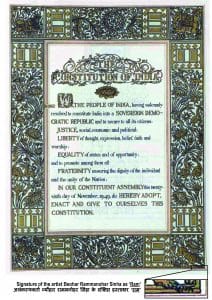AUTHORED BY: MS. NISHITA KAPOOR, B.COM.LL.B, STUDENT AT UNIVERSITY INSTITUTE OF LEGAL STUDIES, PANJAB UNIVERSITY & RESEARCH WRITER AT LAW AUDIENCE.
I. INTRODUCTION:
A statute has many parts such as short title, long title, preamble, marginal notes, headings, definition or interpretation clauses, provisos, illustrations, exceptions and saving clauses, explanations, schedules and punctuation which serve as internal aids to construction. They are considered the internal aids as they are the part of the statute itself.
II. INTERNAL AIDS:
a) SHORT TITLE & LONG TITLE:
The short title of the Act is its name and it is used as a reference to the Act. It is only for the identification purpose and as such has no role in the interpretation of the statute. The statute is headed by a long title, which gives a general description of the object of the Act. For example, the title of Code of Criminal Procedure, 1973 is “An Act to consolidate and amend the law relating to the criminal procedure.” Hence it shows the object to the code is to consolidate all the existing laws on criminal procedure and to amend them.
This also shows that the Act is exhaustive in nature and is not merely illustrative. In the case of Kedar Nath v. State of West Bengal[1], where Section 4 of the West Bengal Criminal Law Amendment Act,1949 was challenged as violating Article 14 of the Constitution as it gave State Government the power to decide that which case should go to Special Courts. The Supreme Court while interpreting the provision in the light of the long title held it to be valid as the long title provided that it is an Act to provide for speedy trial and more effective punishment for certain offences.
b) PREAMBLE:
A preamble is a key to open the mind of the legislature. It contains the main objects of the Act. It may highlight the issues which are redressed by the Act and lays down the scope of the Act. However, if the language of the statute is clear and unambiguous then the preamble has no part to play in the interpretation. The preamble does not have the same weight as the relevant enacting words in the Act itself or in related Acts.
It was observed in the case of Rashtriya Mill Mazdoor Sangh v. NTC (South Maharashtra Ltd.)[2], that where the language of the Act is clear, the preamble cannot be invoked to curtail or restrict the scope of an enactment.
The following observations were made in the case of Attorney General v. H.R.H. Prince Earnest Augustus of Hanover[3]:
- If the rival constructions are put forward before the court and the enacting words of the statute admit of only one construction, then only such construction will receive effect even if it is inconsistent with the preamble.
- If the rival constructions are put forward before the court and the enacting words of the statute are capable of either construction, then the construction which fits the preamble may be preferred.
c) MARGINAL NOTES:
Marginal notes or Side notes are the notes which are inserted at the side of the sections in an Act and they express the effect of the sections. The marginal notes of the Constitution were inserted by the Constituent Assembly and therefore while interpreting the Constitution it is permissible to seek guidance from the marginal notes.
It was held in the case of S.P Gupta v. President of India[4], that if there is any ambiguity in the meaning of the provisions of the statute, the marginal note may be looked into as an aid to construction but it cannot control the main provision.
d) HEADINGS:
Headings are assigned to the sections or to a group of sections. They are considered as a preamble to those sections. Headings act as an aid of construction when there is ambiguity in the meaning of a provision. It was observed in the case of M/S Prick India Limited v. Union of India[5], that headings prefixed to sections cannot control the plain words of a provision, only in case of ambiguity or doubt the heading may be referred to as an aid of construction of provision but even in such a case it would not be used for cutting down the wide application of the clear words used in the provision.
It was held in the case of Iqbal Singh Marwah v. Meenakshi Marwah[6], that headings are not to be treated as if they are the marginal notes or were introduced in the Act merely for the purpose of classifying the enactments. They constitute an important part of the Act itself and may be read not only as explaining the sections which immediately follow them but as affording a better key to the construction of sections which follow them.
e) DEFINITION OR INTERPRETATION CLAUSES:
They are generally included in the statute for the purpose of expanding the natural meaning of some words as per the definition is given or to interpret such words the meaning of which are not clear. Generally, the meaning given to a particular word in the interpretation clause will be given to the word whenever it is used in that statute. The only exception to this rule is that if the court feels that in the context of a particular provision the definition clause if applied will result in an absurdity, the court will not apply the definition clause while interpreting that provision.
Similarly, the definition clause of one Act cannot be used to explain the same word used in another clause. Whenever the words ‘means’ or ‘means and includes’ are used in definition clause they afford an exhaustive explanation of the word in the statute. If the word ‘includes’ is used it is used to enlarge the ordinary and natural meaning of the particular word.
In the case of State of Haryana v. Raghubir Dayal[7], the Supreme Court held that the word ‘shall’ is ordinarily mandatory but it is sometimes not so interpreted if the scope of the enactment, on consequences to flow from such construction, would not so demand.
f) PROVISOS:
The general rule about the interpretation of the statute is that it cannot be construed as enlarging the scope of an enactment when it can be properly construed without attributing to it that effect. The provisos cannot be permitted to defeat the basic intent expressed in the substantive provision.[8] The proviso carves out an exception to the main provision to which it has been enacted as a proviso and to no other.
g) EXCEPTIONS AND SAVING CLAUSE:
Exceptions are enacted with the purpose of exempting something which would otherwise fall within the ambit of the main provision. Saving clauses are appended in cases of repeal and re-enactment of a statute. In the case of Director of Secondary Education v. Pushpendra Kumar[9], it was held that a provision in the nature of an exception cannot be interpreted as to subserve the main enactment and nullify the right conferred by the main enactment.
h) EXPLANATIONS:
Explanations are inserted with the purpose of explaining the meaning of a provision and to remove doubts which might creep if the explanation had not been inserted. They provide additional support to the dominant object of the Act in order to make it meaningful and purposeful.
III. CONCLUSION:
Internal aid to construction is important for interpretation and they are beneficial and reliable than the external aids to construction. The main object of interpretation is to decipher the intention of the legislature, and thus, when the interpretation of the provisions of a statute are made in the light of the other internal parts of a statute itself, there cannot be any doubt about its correctness.
[1] 1964 AC 210 (HL) (India).
[2] A.I.R. 1996 S.C. 710 (India).
[3] 1957 A.C. 436 (India).
[4] A.I.R. 1982 S.C. 149 (India).
[5] A.I.R. 1990 S.C. 689 (India).
[6] A.I.R. 2005 S.C. 2119 (India).
[7] (1995) 1 S.C.C. 133 (India).
[8] Vishesh Kumar v. Shanti Prasad, A.I.R. 1980 S.C. 892 (India).
[9] A.I.R. 1998 S.C. 2230 (India).



